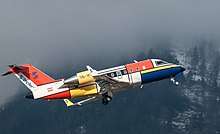Bombardier Challenger 600 series
The Bombardier Challenger 600 series is a family of business jets developed by Canadair and then produced from 1986 by its new owner, Bombardier Aerospace. At the end of 1975, Canadair backed the LearStar 600 concept by Bill Lear, and acquired the large business jet or freighter project in April 1976. On 29 October, the programme was launched, backed by the Canadian federal government, and designed to comply with new FAR part 25 standards.
| Challenger 600/601/604/605/650 | |
|---|---|
.jpg) | |
| A Bombardier CL-604 | |
| Role | Business jet |
| Manufacturer | Canadair (1980-1986) Bombardier Aerospace (1986-present) |
| First flight | 8 November 1978 |
| Status | In production |
| Produced | 1980–present[1] |
| Number built | 1,066 (October 2018)[1] |
| Program cost | C$1.5 billion (US$1.1 at the time)[2] |
| Unit cost | |
| Developed into | CRJ100/200 Global Express |
In March 1977, it was renamed the Challenger 600 after Bill Lear was phased out, as the original conventional tail was changed for a T-tail among other developments. The first prototype was rolled out on 25 May 1978, and performed its maiden flight on 8 November. The flight test program saw a deadly crash on 3 April 1980, but Transport Canada approved the CL-600 type certification on 10 August 1980.
In 1986, Canadair was close to bankruptcy and was bought by Bombardier. The jet was stretched into the Bombardier CRJ regional airliner, introduced on 19 October 1992, and the longer range Global Express, introduced in July 1999. The 500th Challenger was rolled out in May 2000, and the 1000th was delivered to NetJets in December 2015. By October 2018, 1,066 aircraft have been built.
The Challenger is a low-wing jet powered by two turbofans mounted in aft fuselage pods, it has a supercritical wing and a stand-up cabin with two seating sections. The original Lycoming ALF 502 turbofans were replaced by a pair of General Electric CF34s on the CL-601, which also gained winglets, and first flew on 10 April 1982. Subsequent variants have updated systems, avionics, and higher weights.
Development
Origins
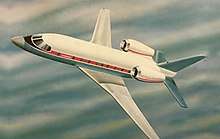
Circa 1974, American aviation inventor Bill Lear conceptualised the LearStar 600, a low-range long-distance business jet which was powered by a pair of Garrett TFE731-1 geared turbofan engines and equipped with a supercritical wing.[4][5] The name LearStar was not original to this concept, Lear had previously used the name for his conversion of Lockheed Lodestars into business transports.[6] However, Lear lacked the capabilities to launch such an aircraft, and thus sought out other agencies to collaborate with to both produce and sell it, including the Canadian aerospace manufacturer Canadair. According to authors Ron Picklet and Larry Milberry, Canadair's top management were of the opinion that Lear's concept was sketchy at best.[7] Lear did not have an expert grasp of aeronautical engineering; so far, he had only been able to pay a California aeronautical consultant to undertake very preliminary design explorations.[8]
Following a study, contrasting the proposed Learstar against rivals such as the Lockheed Jetstar, Dassault Falcon 50, and Grumman Gulfstream II, Canadair decided to give its backing to the idea near the end of 1975.[4][5] According to aerospace industry publication Flight International, the programme was viewed by many Canadians as a step towards developing a privately driven high-technology aviation industry that would compete at a global level.[5] Perhaps more importantly, the Canadian government had issued a demand that Canadair become self-sufficient, thus the company wanted to depend less upon subcontracting arrangements with other firms, such as France's Dassault Aviation and America's Boeing, or providing support packages for existing aircraft that they had already ended production of, such as the CF-5 fighter. Canadair felt a need to prove its ability to independently develop original high-tech projects at this time.[5]
Canadair planned to use Lear's name and skills at self-promotion to secure extensive financial guarantees for a business jet project from the Canadian Federal government.[7] This proved an effective choice: future Prime Minister Jean Chrétien specifically refers to the effect of personal contact with Lear on his decision to direct financial support to Canadair's program.[9] At the time of these events, Chrétien was successively President of the Treasury Board, Minister of Industry, Trade and Commerce, and Minister of Finance, in the Canadian Federal government. Due to the use of letters of comfort, the extent of the Ministry's financial commitments for Canadair could be kept from parliament and the public for several years.[10] These financial guarantees were later used as an academic example of insufficient monitoring and lax controls in government support of industry.[11]
In April 1976, Canadair acquired the LearStar 600 concept. By this point, it was a 63 by 53.3 ft (19.2 by 16.2 m) long and wide aircraft capable of a maximum speed of Mach 0.85 and a range of 7,240 km (3,910 nmi); as an executive jet it had sufficient capacity for 14 passengers, in a freighter configuration it had a 3,400 kg (7,500 lbs) payload capacity, loaded and unloaded via a forward door, or as commuter airliner it could seat up to 30 passengers in a 2–1 seating configuration.[4] Canadair developed the design into a large airframe furnished with a new supercritical wing design, new avionics and engines, as well as for compliance with new FAR part 25 standards. The configuration was frozen in August and a 1/25 model was tested in the National Aeronautical Establishment transonic wind tunnel.[4] Reportedly, in excessof 1,800 hours of wind tunnel testing was performed upon the supercritical wing alone.[5]
Launch
Backed by the Federal Government, the programme was launched on 29 October 1976 with firm orders and deposits for 53 aircraft.[4] Within the next two years, roughly 2,500 employees would be involved in designing the aircraft.[5] Various changes to the original Learstar configuration had been made on the run up to launch, such as the conventional tailplane being substituted for a T-tail counterpart after the former was found to be in the path of the engine's exhaust flow, the relocation of fuel storage to the wings, and multiple increases of the aircraft's gross weight.[4][5] Following disagreements over the direction of the programme, Bill Lear was phased out of involvement; accordingly, in March 1977, the aircraft was renamed the Challenger 600.[4] Reportedly, following his disassociation with the venture, Lear referred to Canadair's revised design as Fat Albert.[5] Following Lear's death in May 1978, Canadair paid an estimated $25 million to his estate for his contribution to the programme.[5]
Due to the expansion of the design, the original powerplant configuration became untenable; thus engine manufacturer Lycoming proposed developing a new model, the Lycoming ALF 502L, which Canadair's design team accepted for the enlarged Challenger and drew up its general arrangement around.[5] The type's wide cargo door had been designed in response to the needs of FedEx, the type's original launch customer, having placed an order for 25 aircraft. Additionally, FedEx had experienced problems with the General Electric CF34 engines, and favoured the Lycoming ALF 502D instead; those later had delivery troubles and lacked performance.[4] Reportedly, FedEx converted most of its orders into the Challenger's stretched version, intending to carry up to 12,500 lb of freight at a time using them.[5] However, FedEx ultimately opted to cancel its orders due to the US Airline Deregulation Act, and the specific aircraft that were already in production were sold to other customers instead.[4]
By the spring of 1977, Canadair had received over 70 firm orders and had begun constructing three prototypes.[4] Furthermore, a $70 million loan was borrowed from European sources to help finance the programme, which lessened the financial burden on the Canadian government.[5] A full-scale fuselage mockup was displayed at the 1977 Paris Air Show before a European and North American tour and 106 had been sold by 1977 end. During late 1977, in the face of criticism that the project would not be capable of producing an aircraft fulfilling the performance guarantees made, Canadair officials had commented that they expected the first flight to occur during the following year and that initial deliveries had been scheduled to commence during September 1979. Flight International noted that even prior to the prototype's first flight, the type had already made a noticeable impact upon the competition, including the launch of the Cessna Citation III and Grumman Gulfstream III.[5]
Airframe structural testing began in February 1979 and operational test cycling started in December 1979, simulating 72,638 flight hours by February 1985 while predicted lifetime was 30,000 hours. By early March 1978, the first prototype was almost finished and the assembly of the two other had debuted; destined to control handling qualities and test flight performance, it was formally rolled out on 25 May 1978, while 116 orders had been confirmed 19 months after go-ahead.[4] By this point, production jigs allowing for a production rate of up to seven Challengers per month had been established, ready for quantity production to proceed.[5]
Flight test phase
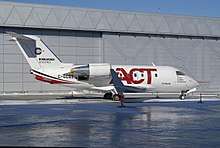
On 8 November 1978, the prototype aircraft took off for its maiden flight from Montreal, Quebec. The flight test and certification program would be conducted at Mojave Kern County Airport instead of Canada due to better conditions.[4] The second and third prototypes first flew during 1979. A test flight on 3 April 1980 in the Mojave Desert resulted in disaster, the aircraft crashing due to the failure of the release mechanism to detach the recovery chute after a deep stall, killing one of the test pilots (the other test pilot and the flight test engineer parachuted to safety).[12]
The CL-600-1A11 type certification was approved by Transport Canada on 10 August 1980,[13] and by the US FAA on 7 November.[14] Its maximum takeoff weight was initially limited, and a modification program aimed at reducing the aircraft's weight was implemented, which had the benefit of improving the aircraft's range.
Further development
During 1980, the first production model of the Challenger series, the CL-600, entered service with end-customers.[15] Early marketing of the type by Canadair typically contrasted the more spacious cabin offered by the Challenger against its competitors, which typically had more narrow fuselages and therefore cramped conditions, as well as the type's fuel economy. By 1982, while only 10 aircraft had entered service, the company had begun publicising a new model of the aircraft, the CL-601, which was to be powered by a pair of General Electric CF34 turbofan engines in place of the original models’ Lycoming units. On 10 April 1982, the CL-601 performed its maiden flight.[16] According to Flight International, the decision to adopt the CF34 engine for the new model was responsible for generating a substantial boom in Challenger sales.[17]
According to Flight International, the slow initial sales of the Challenger heavily contributed to the near-bankruptcy of Canadair, which was only avoided via the purchasing of the company by Bombardier in 1986.[15] Bombardier elected not only to continue production of the type but to finance the development of new models and derivatives. This choice was aided by Canadair's design decision to enable the Challenger to be readily stretched from the onset.[5] As of October 2018, the best-selling variant of the Challenger series has been the CL-604, which was launched in 1995. The 500th aircraft was rolled out in May 2000.[17][18] The 1000th, a 650, was delivered to NetJets in December 2015.[19]
According to Flight International, the Challenger 600 has been a foothold in the market for Bombardier, allowing them to more easily develop further business jets, such as the Bombardier Global Express; another direct derivative of the Challenger series has been the Bombardier CRJ100 series, a larger regional airliner. The publication also commented that the Challenger family "appears to have a solid future", observing a production rate of two aircraft per month throughout 2018.[15]
Design
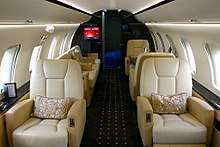
%2C_Canada_-_Air_Force_AN0617967.jpg)
The Challenger is a twin-engined business jet, described by Flight International as being ‘’miniturised twinjet airliner in every respect’’.[5] While the Challenger is generally similar in configuration to previous aircraft of its type, some of its features stand out; for example, the use of a widened fuselage that allows a "walk-about cabin". The Challenger was also one of the first business jets to be designed with a supercritical wing. The wing was referred by Canadair as being one of the aircraft's most advanced features.[5] It is also capable of performing short takeoffs while maintaining the speed and comfort levels normally associated with larger jetliners.[5] Challengers can be identified visually from their peers by their distinctive double slotted hinged flap arrangement, where the fairings can be seen below the wings, a configuration that was much more common on commercial airliners.
The Challenger's wing has been referred to as being a modified NACA symmetrical aerofoil.[5] Akin to other supercritical wings, it features a rounded leading edge, an inverted camber, a blunt trailing edge and scalloping of the underside. The twin-spar wing box structure spans the entire length of the wing and is compartmentalised to form five internal fuel tanks; these tanks can accommodate up to 14,661 lb of fuel, nearly half the aircraft's empty weight.[5] The skins of the wings are produced via large milling machines, which in 1978 were claimed to be in excess of anything else in North America. Many elements, such as the flaps, ailerons and leading edge feature conventional construction; however, several parts, including the wing/fuselage fairing, flap shrouds and wingtips are molded out of Kevlar, as are other elements of the aircraft.[5]
The original CL-600 Challenger was powered by a pair of Lycoming ALF 502L turbofan engines, which was developed specifically for the Challenger.[5] Subsequent models would adopt other powerplants, including the General Electric CF34 engine. The engines are mounted on the rear fuselage close to the aircraft's tail, providing smooth airflow to the engines even when flown at high angles of attack, although this was in a lower position than the original Learstar concept had placed them to mitigate against unfavourable pitch control characteristics.[5] The engines are fitted with thrust reversers to decrease landing distances. An auxiliary power unit is also present for starting the engines and providing air conditioning within the cabin while on the ground.[5]
The fuselage comprises three sections – the nose, centre, and tail – which are manufactured separately in their own jigs and joined late on in the production process.[5] It has been designed to be pressurised at a maximum differential of 9.3 lb per square inch. Various cutouts are present across the fuselage to accommodate various features, such as a large main door on the port side of the aircraft forward of the wing, multiple regulation-compliant emergency exits, a baggage hatch on the port side aft of the wing, and numerous windows.[5] The fuselage's diameter was designed to accommodate an unobstructed cabin floor, a cabin height of 6 ft 1inch in the centre section, as well as space for the wing box, underfloor integral fuel tanks, air ducts, and various control cabling. It was also designed to easily accommodate Canadair's early plans to stretch the fuselage, for which equal-length plugs are installed fore and after of the centre section to vastly increase the Challenger's capacity.[5]
Various avionics are present upon the Challenger. As standard, the CL-600 is furnished with a dual-channel Sperry SPZ-600 automatic flight control system, incorporating a flight director and air data computers; more typical to larger commercial aircraft, this system is certifiable for conducting category 3A automatic landings.[5] The flight control system features significant redundancy, including three individual hydraulic systems; even with complete failure and the loss of one actuator, a viable level of assisted control over the key flight surfaces remains present. Weather radar and Marconi-built solid-state instrument displays are supplied as standard, as well as a Collins-built radio set; optional long range radio-based equipment, such as a HF radio set and VHF navigational aids can be installed.[5]
In a standard executive aircraft configuration, the cabin is divided between the forward galley, and two seating sections, which are typically fitted with a four-chair club section followed by either a conference grouping area or divans, along with a lavatory at the aft end.[20][5] The chairs are fully reclining and can swivel, while the divans can serve as sleeping accommodation. Early examples feature luxuries such as telephones, lighting controls, and stereo systems; foldaway tables attached to the cabin walls were also installed, along with a pair of wardrobes, one fore and one aft, for storing hand luggage and other small items.[5]
Variants
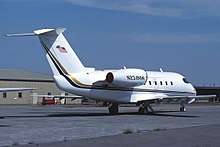
.jpg)
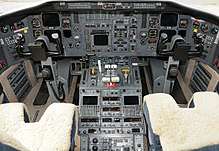
.jpg)
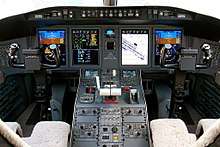
CL-600 (1A11)
- CL-600
- Original production version, powered by Lycoming ALF 502 turbofans of 7500 lbf (33.6 kN) thrust each. Built from 1978 to 1982 (81 built)
- CL-600S
- Three CL-600s retrofitted with the winglets introduced on the CL-601-1A.
- Canadair CC-144
- 12 aircraft purchased by the Royal Canadian Air Force, including the CE-144 and CX-144.[17]
- Canadair CE-144
- Three Electronic warfare / EW trainers converted to/from basic CC-144.
- Canadair CX-144
- Second prototype, a CL-600-1A11, c/n 1002, allocated to the RCAF after finishing test programme. Used at the Aerospace Engineering and Test Establishment (AETE), CFB Cold Lake until retirement in 1993, now preserved at the CFB Winnipeg. Designated CC-144 in service.
CL-601
- CL-601-1A (2A12)
- A refined version including winglets to decrease drag and more powerful General Electric CF34-1A (66 built, including six Canadian Forces CC-144B)[21]
- CL-601-1A/ER
- 601-1A retrofitted with an additional fuel tank in the tail
- CL-601-3A (2B16)
- GE CF34-3A engines with a higher flat rating and a glass cockpit. This was the first version marketed by Bombardier.
- CL-601-3A/ER
- 601-3A with an additional, optional fuel tank in the tail
- CL-601-3R
- The tail tank was made standard, CF34-3A1 Engines were introduced.
- CL-601s
- Version powered by GE CF34-3A2 engines[22]
CL-604 (2B16)
- CL-604
- advanced GE CF34-3B engines; increased fuel capacity including saddle tanks in the rear of the aircraft; new undercarriage for a higher takeoff and landing weight; structural improvements to wings and tail; and a new Rockwell Collins ProLine 4 avionics system.
- CL-604 MMA
- (Multi-Mission Aircraft), militarized version, developed by Field Aviation,[23] in Danish service.[23] The aircraft are employed on maritime patrol and search and rescue missions. They are capable of landing on the short, rough, gravel airstrips common in the Arctic.[23]
- C-143A
- A single Challenger 604 aircraft was acquired by the United States Coast Guard in December 2005 as its new Medium Range Command and Control Aircraft (MRC2A).[24]
Built from 1996 through 2006, over 360 were delivered, early ones were selling for $4.0–$4.5 million and late models for less than $8 million in 2016. With 27,000 to 27,100 lb (12,200 to 12,300 kg) BOWs, it carries 6 to 7 passengers and full fuel with the increased MTOW, is able to cruise 7.5–8.0 hr at Mach 0.80 and to fly five passengers 4,000 nm at Mach 0.74 up to FL 410. Thrust lapse as altitude increases, hefty power and wing loadings affects hot-and-high performance: it takes off in 3,500 to 4,000 ft (1,100 to 1,200 m) for under 800 nmi (1,500 km; 920 mi) missions, in 5,684 ft (1,732 m) at MTOW and sea level but in 9,123 ft (2,781 m) at ISA+20C and 5,000 ft (1,500 m) altitudes, and TOW is reduced to 47,535 lb (21,562 kg) to meet climb requirements.
Pro Line 4 avionics include six 7.25 in (18.4 cm) CRTs and dual FMS. It burns 3,800 lb (1,700 kg) in the first hour, 3,200 lb (1,500 kg) in the second hour, 2,800 lb (1,300 kg) in the third hour then 2,000 lb (910 kg)/hr. Scheduled maintenance is done every 200 h or six months and major inspections every 96 months includes $110,000 landing gear overhauls, the 8,729 lbf (38.83 kN) CF34-3B turbofans costs $375 per engine per hour.[20]
CL-605
- CL-605
- Introduced in early 2006, airframe updated with larger cabin windows and a new tailcone, cockpit updated with the Collins Proline 21 avionics and "electronic flight bag" capability.
- CL-605 MSA
- A maritime patrol aircraft design under development by Boeing.[25] Boeing has proposed a repackaging of some of the Boeing P-8 Poseidon sensors but not weapons into a less expensive airframe, the Bombardier Challenger 605 business jet.[26] This aircraft is named Maritime Surveillance Aircraft (MSA) and has been depicted with the AN/APY-10 radar, an electro-optical sensor in a retractable turret, and a magnetic anomaly detector.[27] On February 28, 2014, a MSA demonstrator which is a modified CL-604 made its first flight, but the final aircraft will use the CL-605 airframe.[28][29] The demonstrator currently has the external shapes for the sensors and communications systems which will be added later. The final MSA is expected to cost $55 million to $60 million per aircraft.[30]
The 605 and 650 improve the avionics and cabin but their performance figures are similar to the 604.[20]
CL-650
- CL-650
- redesigned interior cabin, Rockwell Collins Proline 21 Advanced flight Deck, 5% increase in takeoff thrust.[31] Introduced in 2015.
Operators
The 500th unit was rolled out in May 2000.[32] The 1000th, a 650, was delivered to NetJets in December 2015.[33] Including the Challenger 300 and Challenger 850, the 1,600 Bombardier Challengers in-service had logged 7.3 million hours and over 4.3 million flights by early 2017.[34] As of December 2017, close to 1,100 Challenger 600 Series have been delivered.[35] By October 2018, the global Challenger fleet amounted to 997: of these, 611 were based in North America, 151 in Europe, 93 in Latin America, 78 in Asia-Pacific, 37 in Africa and 23 in Middle East.[36]
Military and government operators
.jpg)
- Australian Maritime Safety Authority operated by Cobham Aviation
- Royal Canadian Air Force: designated as the Bombardier CC-144 Challenger to transport the Governor General, government officials, foreign dignitaries and the Prime Minister of Canada.
- No. 412 Squadron
- No. 434 Squadron (former)
- Croatian Air Force (EMS and VIP Transport)
- German Air Force (seven Challenger 601, retired 2011)
- Korea Coast Guard: operates one CL-604 (B701), outfitted for maritime patrol.[37]
- Pakistan Air Force: Operates 1 CL-605 version, jointly by PAF and Pakistan Army.
- Swiss Air Force: Two CL-604 bought from REGA for air-ambulance duties.[38]
- United Arab Emirates Air Force: 1 Challenger 650 ordered in February 2019.[39]
- United States Air Force
- United States Coast Guard: designated as the Bombardier C-143 Medium Range Command and Control Aircraft (MRC2A),[40] provides VIP transport for high-ranking members of the Department of Homeland Security and U.S. Coast Guard using the designation Coast Guard 02
Civilian operators
- LifeFlight Australia: operates one CL604s modified for medevac.
- Cobham Aviation Services Australia: operates four CL604s modified for Search And Rescue (SAR).
- Air Tindi operates two CL-601s
- Government of Quebec: operates two CL601s (one for medevac).
- North Cariboo Air: operates one CL601.
- Shaw Communications: operates 2 CL604s.
- Sunwest Aviation: operates two CL604s.
- VIH Execujet: operates one CL604.[41]
- Croatian Government: former operator
- Government of the Czech Republic: former operator
- Government Flying Service: operates two CL605s as part of fractional fleet.
- Hornbill Skyways: one CL-605 for state executive flight
- Princely Jets: operates one C604 and one C601-3R
- Qatar Executive: operates three CL605
- Nomad Aviation
- Rega: operates three CL650 for air rescue
- VistaJet Holding SA
- Thai Airways: former operator
- Turkmenistan Airlines for government VIPs. Operates two CL-605's[43]
- Dana Executive Jets: operates one CL604
- Jet Exchange Ltd – CL604 / 605, charter flights
- SkyAngels Air Ambulance operates one CL601-3R for air ambulance missions
- Flex Jet operates a few CL604s and CL605s.
- West Coast Worldwide operates six CL604s.
Incidents and accidents
.jpg)
By May 2019, the Challenger fleet suffered 17 hull loss accidents causing 39 fatalities.[44]
| Date | Location | Fat. | Surv. | Accident |
|---|---|---|---|---|
| 2000-10-10 | US, Kansas, Wichita Airport | 3 | Test flight, impact with terrain during initial climb and post impact fire[45] | |
| 2004-11-28 | US, Colorado, Montrose Airport | 3 | 3 | Crashed during an attempted takeof |
| 2005-02-05 | US, New Jersey, Teterboro Airport | 0 | 14 | Too far forward wing loading, failed takeoff attempt[46] |
| 2014-01-05 | US, Colorado, Aspen Airport | 1 | 2 | Pilot error crash after tailwind landing in low-level windshear and gust conditions after a go-around.[47] |
| 2017-01-07 | Oman, above Muscat | 0 | 9 | 9,000 ft altitude loss after passing through the wake turbulence from an Airbus A380, written off due to damage after emergency landing[48] |
| 2018-03-11 | Iran, Zagros Mountains | 11 | 0 | Crashed after a partial instrument failure, leading to a loss of control[49] |
| 2019-05-05 | Mexico, Coahuila | 13 | Crashed on its return from Las Vegas, Nevada[50] |
Specifications (Challenger 650)

.jpg)
.jpg)
Data from Bombardier[51]
General characteristics
- Crew: Two (pilot & co-pilot)
- Capacity: 2,200 kg (4,850 lb) and up to 19 passengers
- Length: 20.9 m (68 ft 5 in)
- Wingspan: 19.6 m (64 ft 4 in)
- Height: 6.3 m (20 ft 8 in)
- Wing area: 45.4 m2 (489 sq ft)
- Aspect ratio: 8.46
- Empty weight: 12,315 kg (27,150 lb)
- Max takeoff weight: 21,863 kg (48,200 lb)
- Fuel capacity: 9,072 kg (20,000 lb)
- Cabin: 1.83 m / 6 ft 0 in high, 2.41 m / 7 ft 11 in wide
- Powerplant: 2 × General Electric CF34-3B turbofans, 41 kN (9,220 lbf) thrust each
Performance
- Maximum speed: 854 km/h (531 mph, 461 kn)
- Cruise speed: 854 km/h (531 mph, 461 kn)
- Range: 7,408 km (4,603 mi, 4,000 nmi)
- Service ceiling: 12,497 m (41,000 ft)
- Wing loading: 481.6 kg/m2 (98.6 lb/sq ft)
- Thrust/weight: 0.38
- Takeoff: 1,720 m / 5,640 ft (SL, ISA, MTOW)
- Landing: 732 m / 2,402 ft (SL, ISA, typical)
See also
.jpg)
Related development
- CRJ100/200
- Global Express
- Challenger 800
- Challenger 300
Aircraft of comparable role, configuration and era
References
- Murdo Morrison (12 October 2018). "NBAA: Business jet designs that changed the industry". FlightGlobal.
- "Bombardier And The Perils Of Government Interference". Aviation week. February 21, 2020.
- "Business Jets Specification and Performance Data" (PDF). Business & Commercial Aviation. Aviation Week. May 2015.
- Bill Upton (2007). "Canadair CL-600 / 601 / 604 Challenger serial 1003, registration C-GCGT" (PDF). Canada aviation museum.
- Mike Hirst (12 August 1978). "Challenger". Flight International. pp. 470–478.
- Munson, Russell. "Boardroom Bombers: From Warpaint to Pinstripes." Flying, Volume 119, Issue 9, September 1987, p. 96.
- Pickler, Ron and Larry Milberry. Canadair: The First 50 Years. Toronto: CANAV Books, 1995. ISBN 0-921022-07-7. p. 263.
- Logie, Stuart. Winging it: The Making of Canadair's Challenger. Toronto, Ontario: Macmillan Canada. 1992. ISBN 0-77159-145-4, p. 55-57.
- Low, Stephen. Challenger: An Industrial Romance (16 mm, 57 min 23, sound, colour film). Montreal: The National Film Board of Canada, 1980.
- Report of the Auditor General of Canada to the House of Commons for the fiscal year ended March 31, 1982, para. 10.95 to 10.100.
- Borins, Stanford F. and Lee Brown. Investments in Failure. New York: Raven Press, 1987. ISBN 0-458-80340-5.
- "The Crash of Challenger #1001." Check-Six.com. Retrieved: 19 September 2012.
- "Certificate A-131". Transport Canada. 2019-11-22.
- "Type Certificate data sheet A21EA" (PDF). US FAA. November 26, 2019.
- "OPINION: In praise of the Challenger". Flight International. 25 November 2018.
- "Canadair announces yet another breakthrough in the fight against the high cost of jet fuel". Flight International. 29 May 1982. p. 1403.
- "PICTURES: Four decades of the Challenger 600 series". Flight International. 10 October 2018.
- "Bombardier rolls out 500th Challenger business jet". Aviation Week Network. 26 June 2000.
- Kate Sarsfield (21 December 2015). "NetJets' first Challenger 650 enters operational service". Flightglobal.
- Fred George (Aug 25, 2016). "Used Aircraft Report: Challenger 604". Business & Commercial Aviation. Aviation Week.
- Walker, R.R. "CC-144 Challenger detailed list." Canadian Military Aircraft Serial Numbers, Canadian Armed Forces, 2006. Retrieved: September 19, 2012.
- Lombardo, David A. "CF34-3A2 engine upgrade yields longer time on wing." ainonline.com, August 25, 2010. Retrieved: January 16, 2016.
- "Update: Denmark's Arctic Assets and Canada's Response — Danish Air Force Aircraft on a Mission over Canada's High Arctic." Archived 2009-07-09 at the Wayback Machine Canadian American Strategic Review,July 2009. Retrieved: September 19, 2012.
- Parsch, Andreas. "DOD 4120.15-L - Addendum." designation-systems.net, 2011. Retrieved: September 19, 2012.
- Hemmerdinger, Jon. "Boeing's Challenger-based maritime surveillance aircraft nears first flight." flightglobal.com, January 10, 2014. Retrieved: January 16, 2016.
- Gates, Dominic. "Boeing's cheaper surveillance aircraft takes first flight." Seattle Times (seattletimes.com), March 5, 2014. Retrieved: January 16, 2016.
- "Maritime Surveillance Aircraft: Boeing selects a Bombardier 'Bizjet', the Challenger 605, as the preferred airframe for its proposed MSA." Archived 2013-09-23 at the Wayback Machine Canadian American Strategic Review, July 2013. Retrieved: January 16, 2015.
- "Boeing Selects Bombardier business jet for Maritime Surveillance Aircraft Program." Boeing boeing.mediaroom.com, November 18, 2013. Retrieved: January 16, 2016.
- "Boeing's MSA demonstrator proves airworthy." Aviation Today (Access Intelligence, LLC.), March 5, 2014. Retrieved: January 16, 2016.
- Hemmerdinger, Jon. "Field Aviation achieves first flight of Boeing's Maritime Surveillance Aircraft.' flightglobal.com (Reed Business Information), March 5, 2014. Retrieved: January 16, 2016.
- John Morris (Oct 19, 2014). "Bombardier refreshes Challenger 605 as 650". Aviation Week.
- "Bombardier rolls out 500th Challenger business jet". Aviation Week Network. June 26, 2000.
- Kate Sarsfield (21 December 2015). "NetJets' first Challenger 650 enters operational service". Flightglobal.
- "Bombardier Business Aircraft's Service Centre Network Celebrates Completion of over 200 96-Month Inspections on Challenger Jets" (Press release). Bombardier. 17 January 2017.
- "Bombardier's Newest Challenger Jet Models Surpass Significant Delivery Milestones" (Press release). Bombardier. 6 December 2017.
- Max Kingsley Jones (4 October 2018). "ANALYSIS: Challenger 600 marks 40 years in business". Flightglobal.
- "Picture of the Canadair CL-600-2B16 Challenger 604 aircraft." airliners.net. Retrieved: October 6, 2012.
- van der Mark, Kees (August 2019). "Swiss Air Force Challengers". Air International. Vol. 97 no. 2. p. 6. ISSN 0306-5634.
- Martin, Jeff (20 February 2019). "United Arab Emirates Air Force to buy new special mission aircraft". Defense News. Abu Dhabi. Archived from the original on 20 February 2019. Retrieved 20 February 2019.
- "History of Air Station Washington." USCG. Retrieved: September 19, 2012.
- "Private Jet Charter In Victoria BC On Vancouver Island Canada". VIH Execujet. Retrieved 2019-11-01.
- Archived August 22, 2013, at the Wayback Machine
- "Canadair Challenger Statistics". Aviation Safety Network. Flight Safety Foundation. 6 May 2019.
- "NTSB Aircraft Accident Brief." Archived 2016-01-08 at the Wayback Machine aviation-safety.net. Retrieved: January 16, 2016.
- Albright, James. "When Pilots Become Passengers". Business & Commercial Aviation, 24 May 2017 (accessed 22 March 2019)
- Ranter, Harro. "ASN Aircraft accident Canadair CL-600-2B16 Challenger 601 Aspen Airport". aviation-safety.net. Retrieved 7 June 2020.
- Ranter, Harro. "ASN Aircraft accident Canadair CL-600-2B16 Challenger 604 D-AMSC Muscat, Oman". aviation-safety.net. Retrieved 18 May 2017.
- Erdbrink, Thomas (2018-03-11). "Turkish Plane Crashes in Iran". The New York Times. Retrieved March 11, 2018.
- "Aircraft accident Canadair CL-600-2B16 Challenger 601-3A N601VH Monclava". Aviation Safety Network. May 6, 2019.
- "Challenger 650 Factsheet". Bombardier. 2017. Archived from the original on 2017-11-07. Retrieved 2017-11-07.
External links
| Wikimedia Commons has media related to: |
- Official website
- "CC-144 Challenger". Royal Canadian Air Force. 2013-04-10.
- "Canadair Challenger in the air". Flight International. 1 August 1981.
- Mike Gerzanics (21 May 2008). "FLIGHT TEST: Bombardier Challenger 605 - Windows of change". Flightglobal.
- Richard Aboulafia (April 2017). "Bombardier Challenger/Global Series" (PDF). Teal Group.

